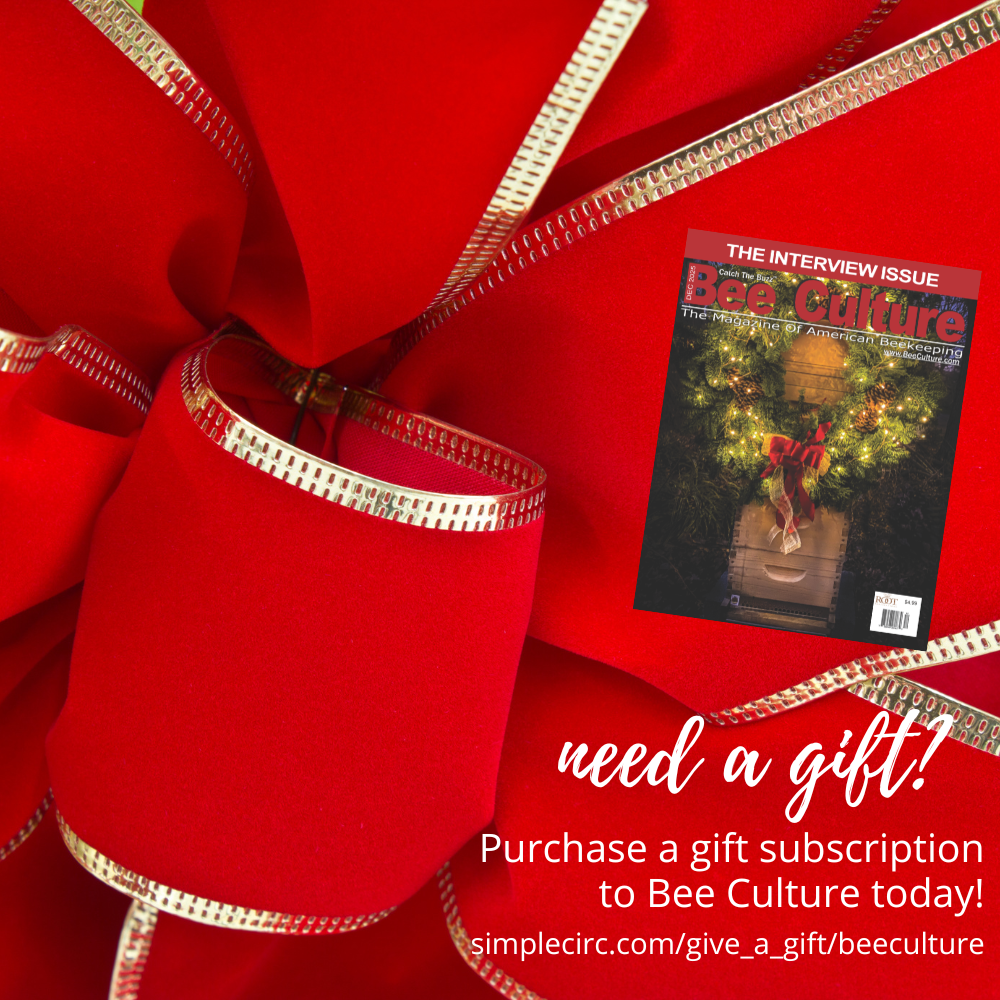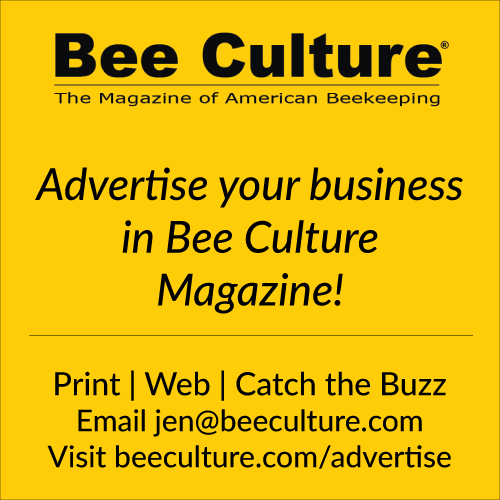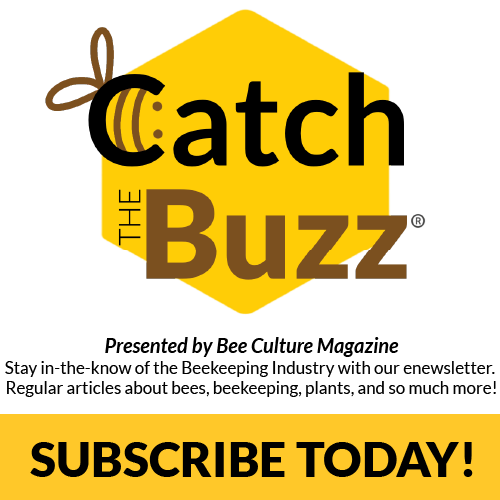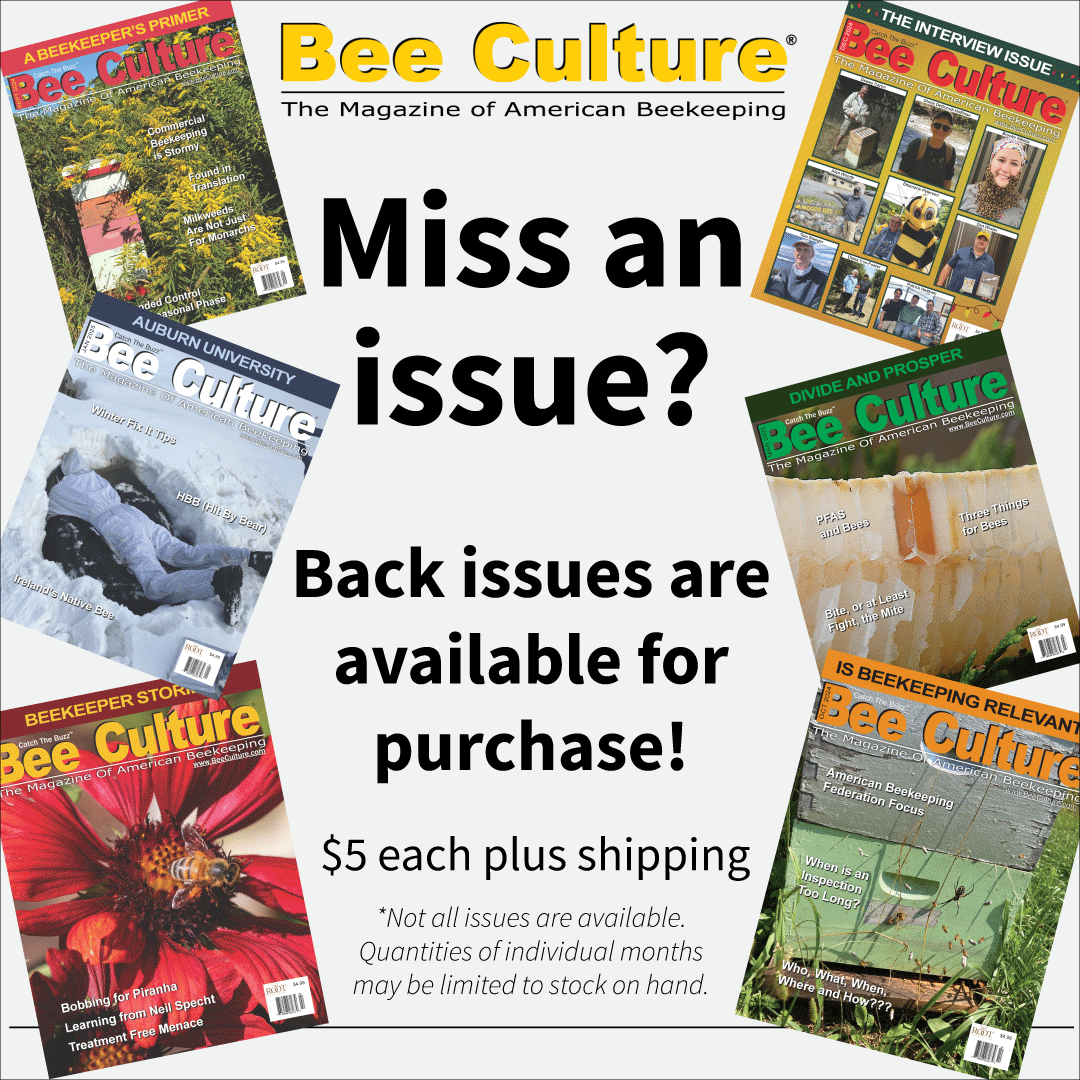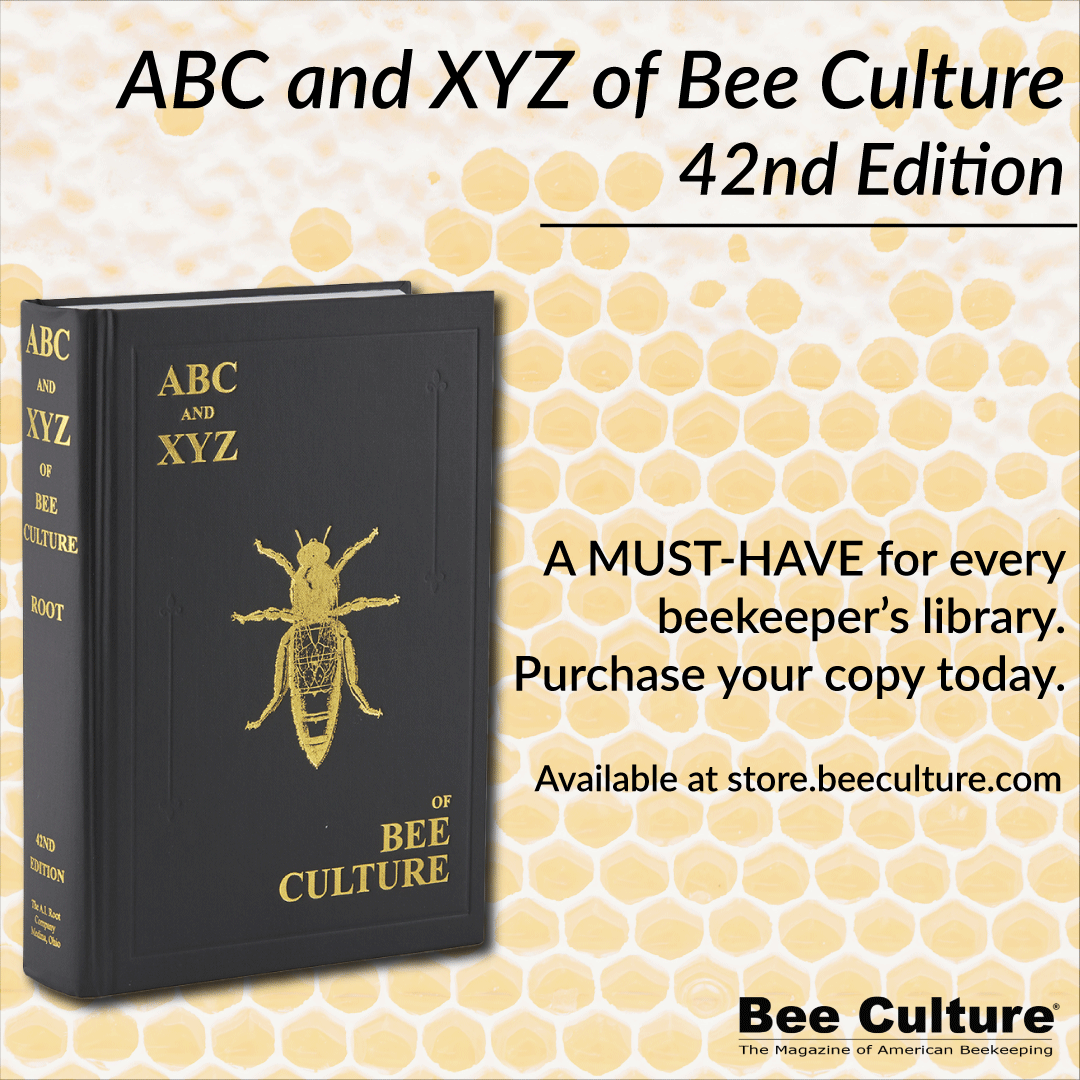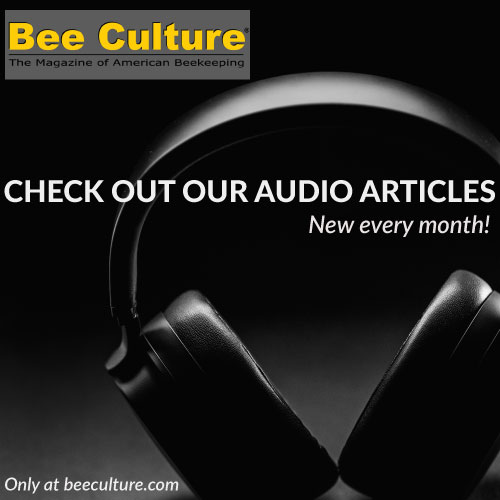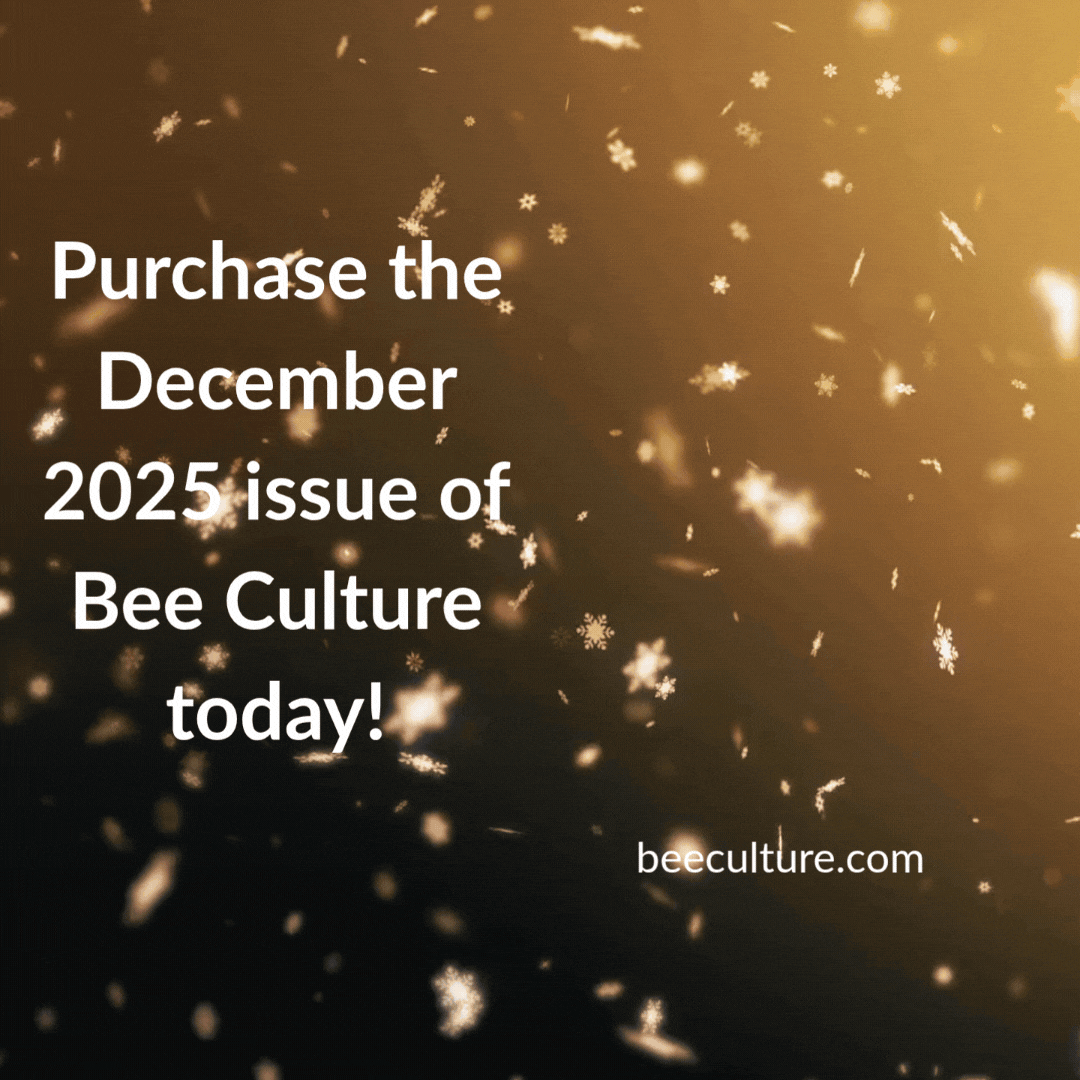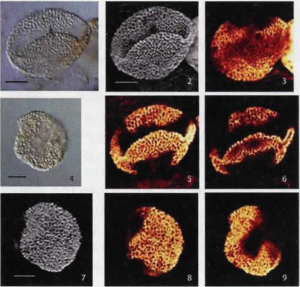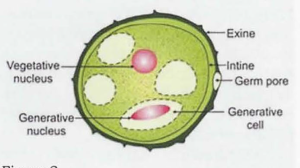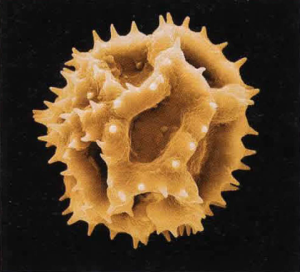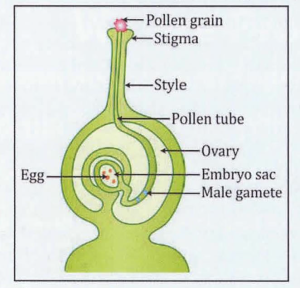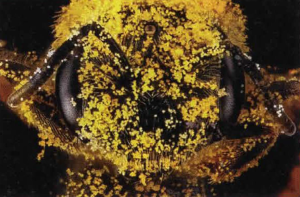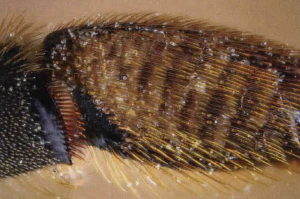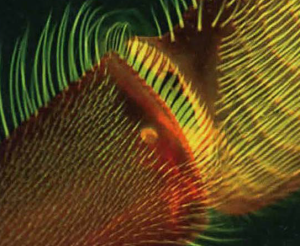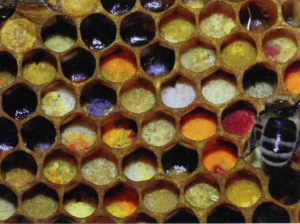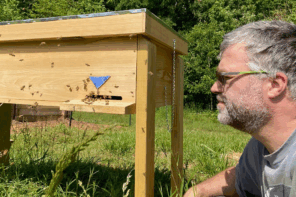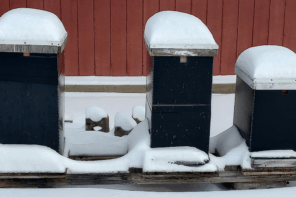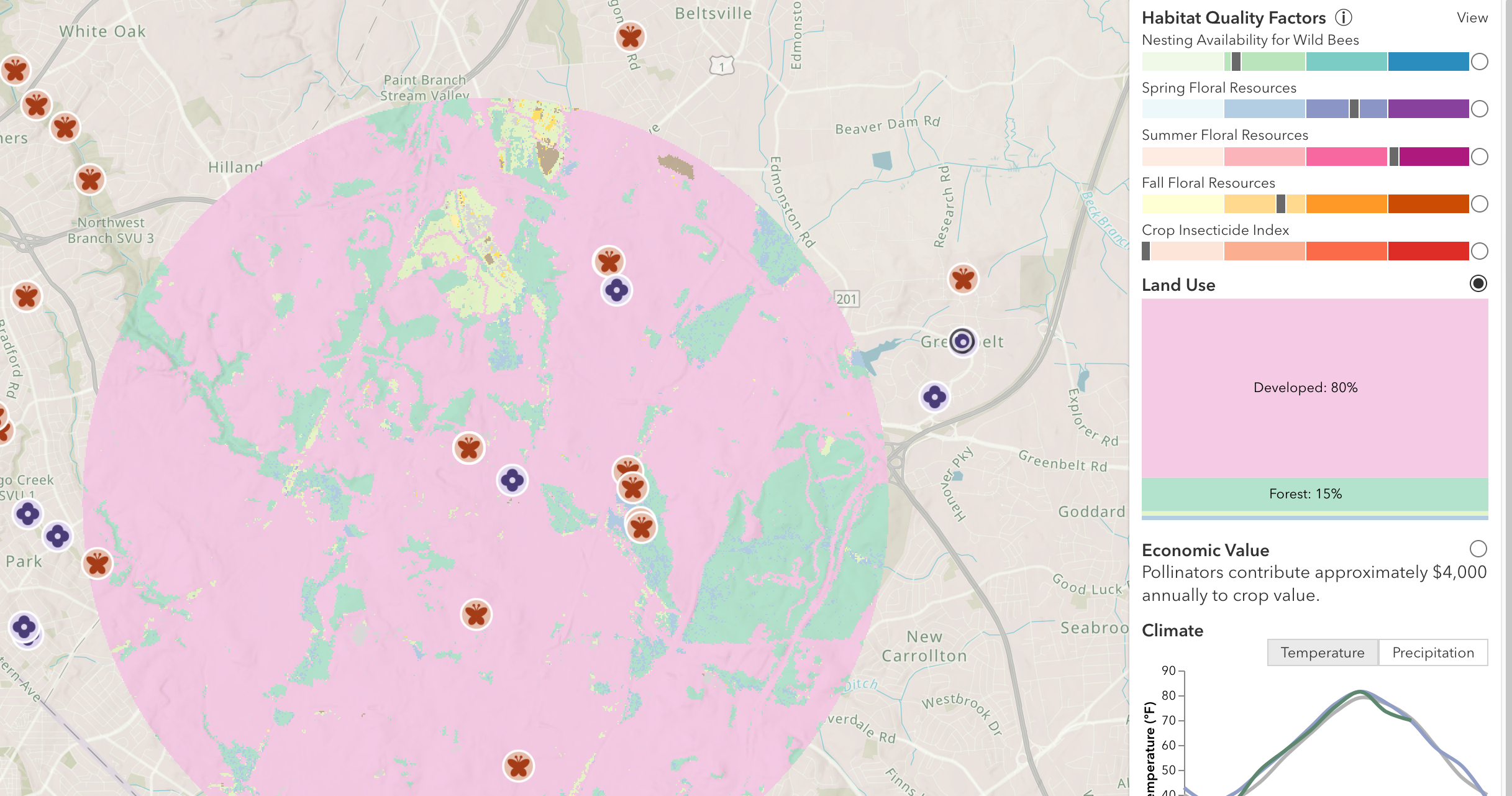By: Bill Hesbach
This article originally appeared in the Autumn 2019 issue of BEEKeeping Your First Three Years
Pollen, the miraculous germ cell of plants and the primary protein nutrient for bees, is the fertility key to every flowering plant and tree in the ecosphere. Honored by Native American Navahos as a path to the source of spiritual life and perplexing to the likes of Darwin, who referred to the origin of flowering plants as the “abominable mystery” pollen, in some form, has been around for about 247 million years.1
While pollen’s primary function is to fertilize plants and supply nutrition for its insect partners, pollen may also play a role in determining the development of queens in a colony. Recent work examined how the genome of honey bees may be regulated by the genome of the pollen they collect in what’s known as cross-kingdom genome interactions2. The fascinating part of this research is the possibility that plant genes and insect genes are linked in a way that allows them to co-evolve as cooperative species. There is a lot to learn about pollen so let’s start at the beginning with some of its fascinating characterizes.
At the origin, it was likely some form of beetle that lumbered up the stalk of an ancient angiosperm (flowering plant) to gather pollen and fertilize the plant. That arrangement is theorized to have lasted for about 100 million years until flying pollinators like bees came on the scene. Since then bees and flowering plants have joined in a fertility covenant that is little changed and still exists to this day.
For plants, pollen is the rough equivalent of the male sperm in animals3, but unlike animal sperm, which are protected inside an organism until fertilization is complete, pollen must survive encounters with a potentially destructive environment on its journey from to plant to plant. Pollen’s almost impenetrable protective layers make it well equipped to survive nearly every circumstance but, as you will see, those same layers present an obstacle for bees seeking the rewards of using it as a protein-rich food.
The mystery and beauty of how a pollen grain can yield freely to a plant and at other times stay intact and unyielding is a story of unprecedented natural adaptation and wonder. What follows unfolds a small part of the alluring story of how plants and bees cooperate so that pollen can serve its dual role as a fertility agent and a food source.
The Pollen Grain
In addition to having specialized surface coatings and microscopic openings, a pollen grain has armored layers biologically equivalent to a medieval castle wall. Layers of defense defy digestion and decay to the extent that angiosperm-like pollen grains have survived from the Middle Triassic period (Figure 1).
One distinctive characteristic comes from a pollen’s unique coating surface referred to as the pollenkitt. The pollenkitt is made of lipids (fats) and other chemicals that waterproof, provide scent, and add color to the grain.4 The pollenkitt is not a defensive layer but rather an attractant and the lipids give the grains a semi-adhesive quality which helps hold the pollen on the plant’s anthers until dispersal. Also, when combed by a bee using its legs to wipe its body clean, the sticky pollenkitt helps adhere the grains as they are moved from leg to leg and finally pressed into the bright colored pellets we see arriving at the entrance.
The first actual layer of defense is called the exine (ek-seen) (Figure 2). You can think of the exine as a resilient plastic or polymer similar to those used for everyday products like water bottles or plastic bee frames. Organic polymers are almost indestructible5 and can resist enzymatic digestion by animals and humans to the extent that eating bee pollen as a human nutrient is not very useful despite all the hype to the contrary.6
The exine is also what gives pollen species their distinctive shape (Figure 3). The unique shape of pollen grains forms the basis of a field of science called palynology, which is the identification of plant species by pollen shape. There’s also a branch of palynology called melissopalynology that uses the pollen grains found in honey to identify the origin of that honey’s plant nectars.7
The exine being a polymer is somewhat elastic and expands with different moisture levels both outside and inside the grain, which plays an important role when the grain germinates. The exine wall also has microscopic openings called apertures or germ pores that allow delivery of its interior proteins during germination of the grain and fertilization of the plant8 (Figure 2).
When a pollen grain fertilizes a plant, it does so by attaching to the stigma, which is the female part of the plant. At that point, the reaction between the pollen grain and the stigma gets very interesting. The stigma hydrates the pollen grain, and the grain responds by beginning to germinate. During germination, the germ pores on the exine begin to exude enzymes. If the enzymes match those needed by the stigma, in other words, if the pollen is the correct species for the plant, fertilization begins.
Fertilization begins with the process of growing a pollen tube down through the style of the plant and into the ovaries9. When the tube is fully developed the sperm part of the pollen grain follows the tube to fertilize the egg10 (Figure 4).
The whole process is governed by a complex and wondrous exchange of protein between the pollen and the plant. The result can be anything from an edible mouthwatering fruit or a simple maple copter seed. That’s the basics of the plant side, now what do the bees get?
How Bees Collect Pollen
In any functional natural system where cross-species are engaged in mutual survival, it’s balanced rewards that make it all sustainable. In the bee and plant world, we have known for centuries that pollen is a reward given back to bees. As an aside, this invariably leads to the perplexing thought of how did the exchange actually begin. No one really knows for sure, and there are scant few hints from the fossil record, so for now, the ageold question of which came first the pollen or the pollinator remains an unsolved mystery.11
Either way, the first task is to collect pollen from a plant’s anthers, and bees have a few tricks to get that done. One is an interesting electrical phenomenon using static electricity. As a honey bee flies through the air, it picks up a positive static change much the same as an article of clothing sometimes does when it comes out of the drier. Static charge makes materials electrically attach, and a bee’s static charge acts the same way with pollen. To understand how a static charge works, it’s helpful to know that everything on a plant that’s touching earth has a negative charge including the pollen grains. When a positively charged bee nears the negatively changed pollen, the grains have a strong magnetic-like attraction much the same as animal hair does to clothing. The attraction is strong enough that, at times, pollen will leap from the plant’s anthers onto the bee before the bee even lands. Of course, after the bee lands on the plant, the process of pollen transfer continues as the bee physically contacts the anthers of the plant.
Once on the bee, the sticky pollenkitt is also at work keeping pollen in place.12 A single honey bee has millions of hairs that cover every part of its body, even the eyes (Figure 5). So the initial pollen load is spread over the entire body. But having those grains all over its body would make flight and navigation difficult, so the second task is to collect all those grains and put them safely in their pollen baskets. Like everything else about bees, using their legs to collect the pollen grains off all the hairs on their body and moving them between their legs on the journey to the pollen baskets has some not so obvious and fascinating peculiarities.
First, is that each set of legs use a special brush on their tibia designated to comb the hairs on a particular segment of the bee’s body (Figure 6). The front legs brush pollen from the head and eyes, the middle legs clean parts of the thorax, and the hind legs clean the abdominal area. It’s interesting to note that not all body hairs on a bee are the same. They have special adaptations to serve the area of the body where they are located. Their length, diameter, and spacing vary, allowing for precise suspension of pollen grains above the particular contours of the bee’s body. Even with the all that specialization, the collection process is not immediate or completely thorough. For example, it can take a bee twenty strokes before its eyes are cleaned, and even then some grains remain in place.12
Once a leg’s brush has collected pollen, the process of moving the pollen from leg to leg ending on the back leg’s baskets begins. Bees know when to do this because each leg has specialized hairs that act like mechanical sensors signaling the need for pollen movement. Those same hairs also signal that movement has occurred. Bees also use sensor hairs, on their rear legs, to tell when their pollen baskets are full signaling that it’s time to return to the colony.13
Movement of pollen from leg to leg is another one of those not so obvious behaviors because even as you watch, it’s not apparent what’s happening. Bees don’t move pollen straight back from legs on one side of their body to the basket on that same side. The pollen grains end up crossing the bee’s body from the left to right and vice versa. The exchange happens at the middle legs, and I’ve watched bees in the process a number of times, and have even filmed it, (https://youtu.be/PrCTUolSRPM) but I still can’t say I’ve seen it happening because it’s done amazingly fast. After all the pollen grains are moved, the process ends on the rear leg where the pollen is pressed into a pellet using specially adapted hairs on the rear leg appropriately named the pollen press (Figure 7). The pellet is formed around a single course hair, called the pollen pin, which holds it securely during the flight back home.
How Bees Digest Pollen
Once back at the colony, pollen is either consumed by nurse bees for the immediate production of brood food or placed in cells for later use. The storing of pollen in cells begins a fermentation process fostered by the growth of bacteria and yeasts that naturally occur on the grains. The fermentation provides the grains with a more suitable biochemical environment for long-term storage that we refer to as beebread. Although beebread involves fermentation, the individual grains remain unchanged. So whether a bee eats fresh pollen, which they prefer, or beebread, they’re up against the same task of extracting the protein from grains.
It would be simple if a bee’s mandibles were strong enough to break a grain open, but they’re not. Instead, pollen consumed by bees is, in theory, subject to a form of predigestion that mimics natural pollen germination. When bees consume pollen, the grains end up in their honey crop where they are mixed with a sugar and acid solution. In that solution, most pollen species will start pseudo-germination and grow instant pollen tubes mimicking the process of natural tube growth that occurs down a plant’s style.14 The pollen grains are then passed to the midgut where the nutrients gradually empty from the grain.15 Studies of pollen digestion in other bee species have included another process that involves pressure when the grains pass from the honey crop to the midgut. The theory suggests that the grains may burst due to a change in pressure (osmotic pressure) as they move into the midgut. The argument has some support, but there’s still skepticism from the lack of observable evidence in honey bees.
The last part of the process is how pollen passes through the midgut during digestion. Pollen grains don’t just travel freely from the honey crop to the midgut, but rather the grains are packed together and encapsulated in a porous membrane just as they leave the honey crop. The membrane package, or bolus, then travels through the midgut while digestive enzymes, and possibly osmotic pressure works to extract the protein. The time it takes for the bolus package to move through the midgut and into the hindgut as waste depends on the pollen type. If you were to look at pollen grains in the hindgut, you would discover that not all are digested. Approximately 30% of consumed pollen goes undigested, and that number can vary by species. Some species, like dandelion, resist digestion while others like clover, that has a thin-walled exine, are more digestible.16 In the hindgut, digested grains look like a collapsed balloon while those undigested look as good as new.
Protein Contents and Collection
Bees need ten amino acids for both normal larval growth and continued health as adults. It’s important to note that very few pollen species provide all 10, so it’s critical that bees forage on a variety of sources (Figure 8). Other factors that determine the protein content are soil types, regional climate, and the season. Spring pollens tend to be more nutritious, which works favorably with the Spring build.17 Influenced by soil type and the environment, some pollen will yield protein in the 9% range while others can be as high as 37%. Which leads to the question why don’t bees just forage on the most nutritious source? The answer comes from studies that have shown, while proficient at distinguishing among nectar sources based on sugar content, bees don’t make a distinction based on the protein content. At times, bees will collect lots of things that aren’t even pollen like birdseed, sawdust, and even fungus.18
Although bees don’t make a distinction based on protein content, they are attracted to an abundant source. As a result, you will sometimes observe a single pollen species on almost every returning bee. The allure for abundance was documented in one pollen study conducted on a large field of highbush blueberries receiving pollination services. The results showed that bees were drawn away from the blueberries by two competing sources of pollen. The data from. trapped pollen showed that only 4% of the returning pollen was blueberry pollen. The bulk of the remainder was split between wild dogwood and cherry pollen.19
One of the calming pleasures, bordering on meditation, is to take some time and watch as bees return with full baskets of pollen then land and walk into the entrance. If you miss the returning bee in flight, you can sometimes see the light colored pellets flash like taillights as bees enter the hive’s darkness. It’s fun to watch, but it’s more important to figure out the pollen species coming in during the season.
I encourage beekeepers to first survey their area for available pollen sources by plant species. It’s as simple as walking around and observing. Once some are identified, I suggest starting a log or preferably a calendar based on bloom times and color. The most accurate way to identify the color of a pollen species, in its pellet form, is to observe bees on the plant when actively collecting. On the plant, the bees’ pollen baskets will provide the actual pellet color because after bees add nectar and compress the pellet, the color looks different than what you see on a plant’s anthers.
An excellent time to start identifying pollen is with the first pollen of the season because there’s not that much blooming at that time to confuse species. When I see yellow or light grey pollen in late February, it’s likely skunk because they document the return of a dependable cycle, and they can help predict brood rearing and honey flows.
What’s in Your Pollen?
After your list is started, you can then ask the question of whether your area’s floral sources provide adequate protein. As mentioned, bees need pollen that contains 10 essential amino acids for good health.20 Since bees cannot synthesize essential amino acids metabolically, they must be derived from the digestion of raw pollen. Most pollen will have at least nine of the ten needed. If there is any scarcity at all, it will probably be with the single amino acid tryptophan, which frequently comes up missing in pollen. The one dependable source of tryptophan is the clover family (Trifolium), which in my area is known as White Dutch Clover. There are also many other species in the family including peas and beans, so odds are your bees collect tryptophan in most years.
It can be a little challenging to figure out the amino acid content by pollen species because we are missing needed reference material for U.S. beekeepers. We need a list of regional plants that provide details like the amount of pollen they produce and the amino acid content. As an alternative, I reference an Australian study called Fat Bees Skinny Bees.21 Although they are Australian plants there are a surprising amount of similarities that provide useful comparisons.
While amino acid references require some digging, there’s another way to measure the adequacy of incoming pollen, and it’s the time-proven method of simple observation. For instance, if your bees collect a variety of pollen, indicated by different colors, and the brood is pure white and plump, chances are their protein needs are being met. Observation will also reveal the lack of adequate incoming pollen during brood rearing. Since the production of brood food requires lots of pollen, I look at young larvae to ensure that they are floating in a rich reservoir of brood food. Dry larvae can indicate a temporary pollen dearth but if prolonged, it can suggest a larger source-based problem with your area’s availability -your bloom calendar and experience will help answer those questions.
Pollen’s importance in the ecosphere is undeniable, and for bees the same is true. We often equate potency with size, but in the world of plant fertilization, pollen’s silent exchange of genes providing the world with many riches, and its role as a life-sustaining nutrient makes the microscopically small pollen grain a biological giant, one that’s both humbling and amazing to observe. Take care of your bees.
Bill Hesbach owns and operates Wing Dance Apiary in Cheshire CT. He’s also an EAS Certified Master Beekeeper.
References and End Notes:
1 Angiosperm-like pollen and Afropollis from the Middle Triassic (Anisian) of the Germanic Basin (Northern Switzerland) Peter A. Hochuli, and Susanne Feist-Burkhardt
2 Plant microRNAs in larval food regulate honeybee caste development Kegan Zhu, Minghui Liu, Zheng Fu, Zhen Zhou, Yan Kong, Hongwei Liang, Zheguang Lin, Jun Luo, Huoqing Zheng, Ping Wan, Junfeng Zhang, Ke Zen, Jiong Chen , Xi Chen Published: August 31, 2017,https://doi.org/1O.1371/ joumal.pgen.1OO6946
3 Andrea D. McCue, Mauro Cresti, Jose A. Feij6, R. Keith Slotkin; Cytoplasmic connection of sperm cells to the pollen vegetative cell nucleus: potential roles of the male germ unit revisited, Journal of Experimental Botany, Volume 62, Issue 5, 1 March 2011, Pages 1621- 1631, https://doi.org/1O.1O93/jxb/err032
4 Pollen nutritional content and digestibility for animals T. H. Roulston and J. H. Cane
5 Sporopollenin is the actual name that describes the biopolymer that makes up the exine layer. For further reading see this paper: Sporopollenin, the least known yet toughest natural biopolymer Grahame Mackenzi, Andrew N. Boa, Alberto Diego-Taboada, Stephen L. Atkin, and Thozhukat Sathyapalan https:/ /www. frontiersin.org/ articles/ 10.3389 / fmats.2O15.00066/full
6 Microspectrophotometric evaluation of digestibility of pollen grains. Franchi GGl, Franchi G, Corti P, Pompella A.
7 Forensic melissopalynologists were the first to discover the true national origin of different kinds of honey shipped to the US under false country-of-origin labeling.
8 The role of the intine and cytoplasm in the activation and germination processes of Poaceae pollen grains Jesus Marquez, Juan A. Seoane Camba & Maria Suarez Cervera https://www.tandfonline.com/doi/pdf/10.1080/00173139709362626
9 The pollen tube varies in length depending on the plant species. It is theorized that the amount of protein in a species of pollen, is proportional to requirements needed to grow the tube.
1O Sperm Delivery in Flowering Plants: The Control of Pollen Tube Growth Kathleen L. Wilsen Peter K. Hepler
11 Evolution: Pollen or Pollinators – Which Came First? Simone C.Cappellari, HannoSchaefer, Charles C. Davis https://doi.org/10.1016/j.cub.2013.02.049
12 Honey bee hairs and pollenkitt are essential for pollen capture and removal Guillermo J Amador, Marguerite Matherne, D’Andre Waller, Megha Mathews, Stanislav N Gorb, and David L Hu Published 23 March 2017 Bioinspiration & Biomimetics, Volume 12, Number 2 http://iopscience.iop.erg/article/10.1088/1748-3190/aa5c6e/meta
13 Displacement sensors in the honeybee pollen basket H.R. Hepburn, F.B. Moseley, R.J. Rigby Journal of Insect Physiology Volume 27, Issue 5, 1981, Pages 339-346 https://doi.org/10.1016/0022-1910(81)90080-9
14 Pollen nutritional content and digestibility for animals T. H. Roulston I and J. H. Cane 2
15 The protein balance of the honey bee worker K Crailsheim https://www.apidologie.org/articles/apido/pdf/1990/05/Apidologie_0044-8435_1990_21_5_ART0004.pdf
16 Ranking pollen from bee plants according to their protein contribution to honey bees Vasilis Liolios, Chrysoula Tananaki, Maria Dimou, Dimitrios Kanelis, Georgios Goras, Emmanouel Karazafiris & Andreas Thrasyvoulou
17 Ranking pollen from bee plants according to their protein contribution to honey bees Vasilis Liolios, Chrysoula Tananaki, Maria Dimou, Dimitrios Kanelis, Georgios Goras, Emmanouel Karazafiris and Andreas Thrasyvoulou
18 Shaw, D.E. (1990). The incidental collection of fungal spores by bees and the collection of spores in lieu of pollen. Bee World, 71, 158-176. doi:10.1080/0005772X.1990.11099059
19 Pollen preferences of honeybees sited on four cultivated crops* Larry G. Olsen, Roger Hoopingarner, and E. C. Martin Journal of Apicultural Research 18(3): 196-200 (1979)
20 The ten essential amino acids required by bees are: Threonine, Valine, Methionine, Isoleucine, Leucine Phenylalanine, Histidine, Lysine, Arginine, Tryptophan
21 Fat Bees Skinny Bees is a free download with lots of information on honeybee nutrition. The plants listed in the amino acid tables are Australian of course but lots of species are similar and can aid you in determining the amino acid contents of US plants. Click “Download PDF” from the link below. https://www.agrifutures.com.au/product/fat-bees-skinny-bees-a-manual-on-honey-bee-nutrition-for-beekeepers/

